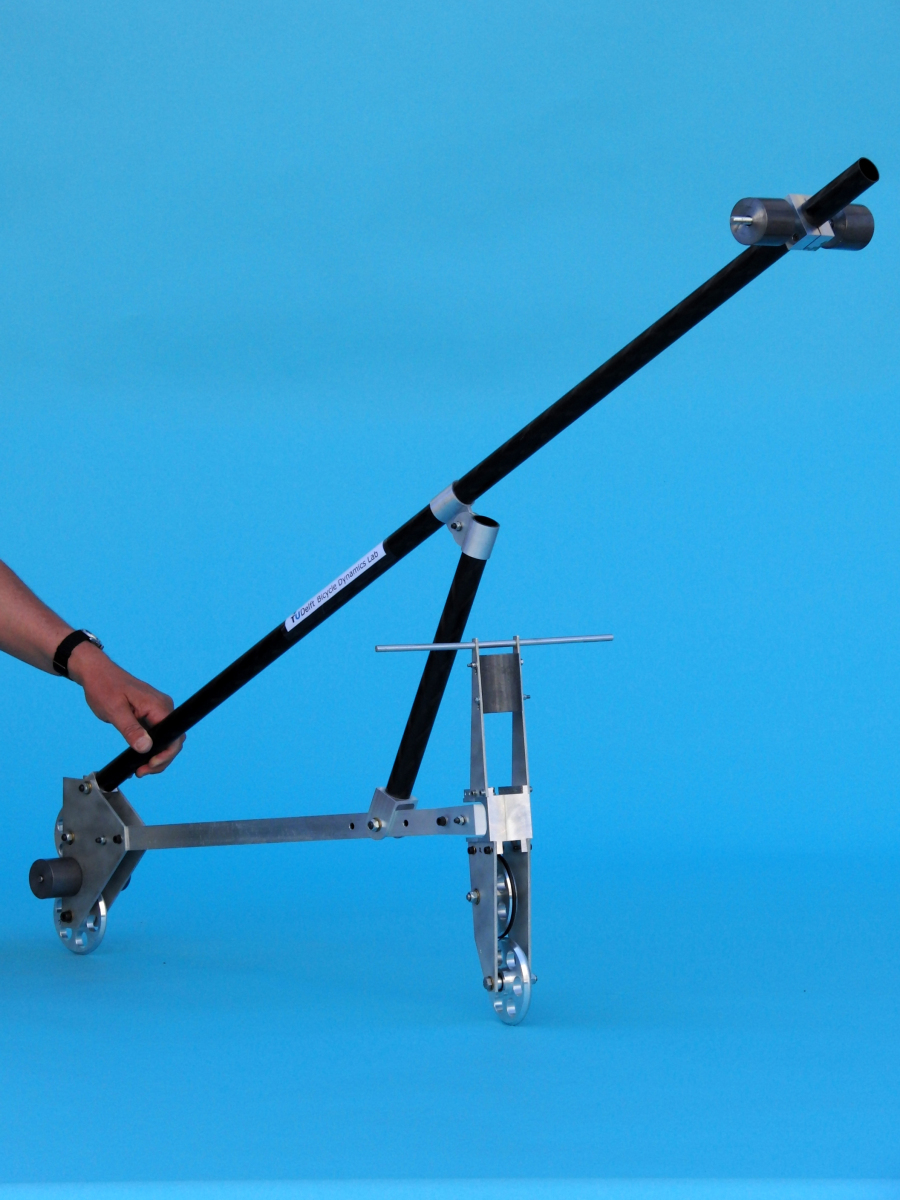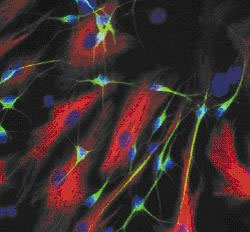In NewsFlash this week, how ums and ahs can boost a baby's learning power, how mankind talked his way out of Africa, and how life on land evolved earlier than we thought. Plus, how scientists are viewing schizophrenia in a Petri dish and an insight into how a rider-less bicycle remains upright.
In this episode

00:17 - Um, that's the way we learn
Um, that's the way we learn
Frequently seen as a sign of verbal indecision or weakness that should be avoided, parents who "um" and "er" in front of their children are in fact likely to be boosting their offspring's mastery of language...
Writing in Developmental Science, University of Rochester researcher Richard Aslin and his colleagues made the discovery by exposing a group of two-and-a-half year old toddlers to a series of images of pairs of objects, one of which was something they were familiar with, and the other an item they had never seen before.
Just before the objects were presented, a voice instructed the children to look at one of them. But sometimes the voice included an "ah" or "um" - known in common parlance as a speech disfluency - just before the name of the object; so, for example, the children would hear the instruction "look at 'thee', um, wrench".
While this was going on, a computer, running eye-tracking software, scrutinised where the toddlers looked and for how long.
What the researchers found was that when an instruction contained such a disfluency for an unfamiliar object, the toddlers looked for much longer - almost 70% of the time compared with 54% normally - at the novel, unknown item on the screen.
This effect was also specific to the two and a half year olds, the group found, because when they tried it with a children under two it didn't work. This strongly suggests, Aslin says, that children rapidly learn that when someone utters a disfluency (um or er), which usually also follows a long "the", pronounced "thee", there will likely follow a word that is more rarely used - hence the delay as the adult searches their mind for it - and which should be attended to because it's probably unknown.
This technique, which continues in adulthood and probably also underlies the importance of making appropriate pauses in speech and comedy in order to attentionally-prime an audience, enables the toddler to pick up what's relevant amongst the barrage of novelty with which it constantly assailed.

04:36 - Freshwater favours the evolution of complex cells
Freshwater favours the evolution of complex cells
This week, researchers have found evidence to suggest that life evolved on land much earlier than previously thought. These fossils come from a key point in evolution where tiny, simple bacterial (prokaryote) cells developed features resembling larger, more complex (eukaryotic) cells which would make photosynthesis and sexual reproduction possible.
 According to the paper published in Nature, microfossils have already been found that demonstrate life existed in the sea over three billion years ago but very little is known about early signs of life on land.
According to the paper published in Nature, microfossils have already been found that demonstrate life existed in the sea over three billion years ago but very little is known about early signs of life on land.
Paul Strother of Boston College and colleagues looked at microfossils found in billion-year-old rocks in northwest Scotland's Loch Torridon. The life-forms they looked at were eukaryotes: organisms whose cells contained complex structures inside cell walls, measuring up to a gargantuan one millimetre long.
The authors say that because of the presence of structures like a nucleus, chloroplasts and mitochondria, these simple eukaryotes must have lived in fresh water and were exposed to the open air because they have the parts necessary to perform photosynthesis.
The authors argue that it also supports the idea that prokaryote cyanobacteria evolved first in freshwater habitats and later migrated into the sea. And early cyanobacteria are thought to be the cells which ultimately became chloroplasts in plant cells; or in this case these early eukaryotes, which are thought to be a precursor to algae. The authors add that what it could mean is that freshwater habitats are better at encouraging eukaryotic evolution than the sea.

06:38 - Mankind talked his way out of Africa
Mankind talked his way out of Africa
According to the "out of Africa" hypothesis, modern humans evolved in Africa several hundred thousand years ago. Then, from about 50,000 years ago, our ancestors ventured farther afield, ultimately settling worldwide. This is supported by genetic studies, which confirm that the richest genetic diversity is seen amongst African natives, and the least amongst those populations at the tips of the migratory branches early humans followed around the world. But now a scientist at the University of Auckland has added another layer of complexity to the story - the role that human language might have played in the exodus from Africa.
 Writing in Science, Quentin Atkinson analysed the number of phonemes - the units of sound that make up words - used in 504 world languages. As a general, rather like genetic diversity, languages spoken by large populations tend to have more phonemes than languages spoken by small or bottle-necked populations. Strikingly, this language phoneme count matches up very closely with the migration pathways predicted by previous genetic and morphological studies.
Writing in Science, Quentin Atkinson analysed the number of phonemes - the units of sound that make up words - used in 504 world languages. As a general, rather like genetic diversity, languages spoken by large populations tend to have more phonemes than languages spoken by small or bottle-necked populations. Strikingly, this language phoneme count matches up very closely with the migration pathways predicted by previous genetic and morphological studies.
The African languages are the most richly endowed with phonemes while those languages spoken by peoples at the distant tips of the migratory branches contain the fewest. The implication of this result is that, for the relationship to fit, language must have evolved amongst modern humans whilst they were still in Africa. According to Atkinson "to the extent that language is a marker of cultural identity, our cultural ancestry, like our genetic ancestry, can be traced all the way back to Africa, which I think is quite remarkable." And this acquisition of language is, Atkinson thinks, probably the catalyst that mobilised early man out of Africa. "Humans carried with them in their toolkit from Africa, language, and all the advantages that confers, including coordination and cooperation, giving us a competitive advantage."

12:41 - Self-righting bicycle
Self-righting bicycle
A team working in the USA and Holland have this week come one step closer to working out how a rider-less bicycle remains upright. As you know, this only happens when the bike is moving, so there must be some interesting mechanical forces at work keeping it from toppling over.
 What happens when the bike coasts is that, each time it starts to fall to one side, the front wheel will steer into the fall and so correct it - making the bike upright again.
What happens when the bike coasts is that, each time it starts to fall to one side, the front wheel will steer into the fall and so correct it - making the bike upright again.
For some time the conventional wisdom has been that two principal forces cause this corrective steering to occur. The first of these is a sort of precession - otherwise known as gyroscopic torque. This is when something spinning in a particular direction provides a force that acts on the axis of the spin. For example, if you have one of those spinning tops where you pull a piece of string to make it spin, the spinning motion keeps it upright as gyroscopic forces pull on the axis to create a sort of self-correcting balance. When the top is not spinning, it simply topples over on one side. For a long time it's been thought that the same effect happens on the bicycle wheel.
The second effect is the caster effect. You'll see this on shopping trolley wheels where, when you steer it around corners, the wheels appear to get dragged around behind the direction you're steering it in. And this is because they're set on posts which are (if viewed from the side) in front of the position where the wheel meets the ground. The same thing is effectively true of a bike, because the place where the wheel meets the ground is actually slightly behind the steering axis.
Publishing in Science, this team built a bike that counteracted these two effects, to see if it would still stay upright when moving. Jodi Kooijman
But... when they let this construction roll alone, it still managed to balance upright. Further, it didn't lose its balance as it went faster - unlike normal bikes.
The researchers think that there must be something else going on, possibly related to mass distribution. They also argue that, until we fully understand the mechanics behind them, bikes today could be falling well-short of their design potential.

15:44 - Schizophrenia in a petri dish
Schizophrenia in a petri dish
One person in every hundred has schizophrenia, and 85% of cases occur in families with a known history of the disease. But despite being so common, the causes of condition remain shrouded in mystery. Now scientists have found a new way to gain a fresh insight into the disease - by propagating patient's own nerve cells in a culture dish.
 Writing in Nature, Salk Institute scientist Fred Gage and his colleagues explain how they took skin cells from four schizophrenia sufferers and then, using a genetic technique, reprogrammed these skin cells to become stem cells, which they were then able to turn into brain cells that could be cultured and studied. Compared with control neurones produced using the same technique but starting with skin cells from non-schizophrenics, the nerve cells produced from the patients showed reduced connectivity - in other words made fewer chemical connections called synapses - with other nerve cells and they also put out fewer nerve branches.
Writing in Nature, Salk Institute scientist Fred Gage and his colleagues explain how they took skin cells from four schizophrenia sufferers and then, using a genetic technique, reprogrammed these skin cells to become stem cells, which they were then able to turn into brain cells that could be cultured and studied. Compared with control neurones produced using the same technique but starting with skin cells from non-schizophrenics, the nerve cells produced from the patients showed reduced connectivity - in other words made fewer chemical connections called synapses - with other nerve cells and they also put out fewer nerve branches.
The researchers also exposed the cells to a number of antipsychotic drugs used to treat schizophrenia; one, called loxapine, reversed some of the observed connectivity deficits. But even more powerfully, the team were also able to compare how the gene activity profiles of the schizophrenic neurones differed from that seen in the healthy nerve cells, identifying in the process 596 genes that were being expressed differently in the two cell types. One quarter of these have previously been tied to the condition, but the others represent new avenues that could be followed, including from a therapeutic perspective. Indeed, exposing the cells to the antipsychotic drugs produced significant changes in the activities of a large number of genes.
According to Kristen Brennand, the lead author on the paper, "These drugs are doing a lot more than we thought they were doing. But now, for the very first time, we have a model system that allows us to study how antipsychotic drugs work in live, genetically identical neurones from patients with known clinical outcomes, and we can start correlating pharmacological effects with symptoms."
Related Content
- Previous The Power of Magnetism
- Next DNA-away Disease: Gene Therapy at Work










Comments
Add a comment